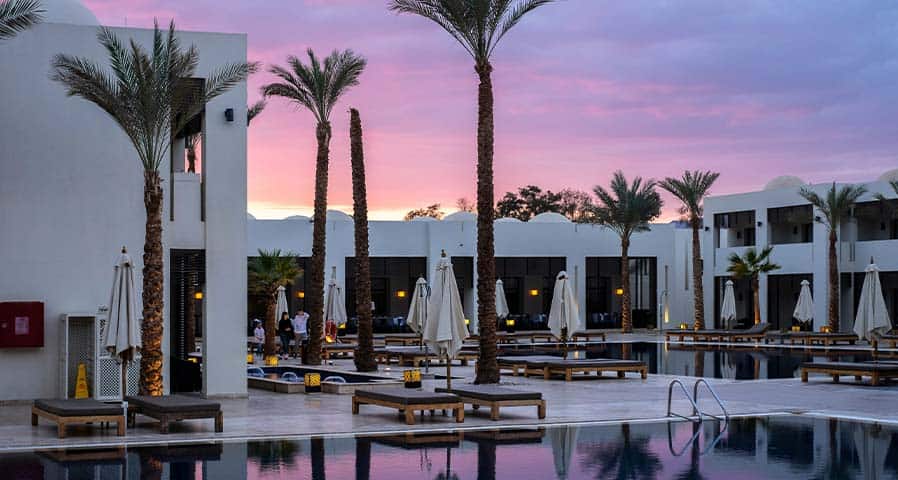Daylighting Controls & Daylight Savings: Optimizing Natural Light Through the Changing Seasons
Studies have shown that natural lighting has proven to improve workplaces by helping employees be more comfortable and efficient. As…

You don’t need a five-star rating to have a great hotel. However, you do need great hotel lighting to provide your guests with a memorable experience. The right hotel lighting can create a pleasant, welcoming, and functional environment. The right lighting can make every area of the hotel a comfortable space and guide guests around safely.
Here are some tips to ensure your hotel lighting is everything guests expect and more.
Various areas in the hotel have different lighting needs.
For example, you want brighter lighting in hallways used by staff. In restaurant and bar areas, softer light creates a more relaxing and intimate atmosphere.
The lighting should reflect the style of the hotel while also being functional and creating an environment that makes guests feel welcome and comfortable. Sometimes, this requires a creative approach to hotel lighting.
Here are a few tips on how to illuminate the various areas of your hotel.
A hotel’s lobby gives guests their first impressions of the property. The light should reflect the impression you want to give your guests. Some hotel lobby lighting tips include using dominant lighting to illuminate the reception desk. You can also go with a more intimate and welcoming light with warm colors to welcome guests and create an intimate atmosphere.
With LED hotel lighting you can create a balance in the hall using vertical and horizontal fixtures. This can guide guests around the lobby and surrounding areas without being overly bright or too dim.
Did you know that light color and intensity can affect your mind and brain? This holds double true when traveling and needing a comfortable place to rest and relax. Learn more about the effects of your lighting in our blog, How Light Color and Intensity Effect Your Mind and Body.
Hotel corridors require functional lighting to identify pathways to rooms, stairs, and elevators. You need a variety of lighting levels, especially in longer corridors.
Ceiling and wall lights can make a corridor seem less closed in. Mixing the fixtures can also make long corridors seem shorter and more welcoming.
Guests perceive light differently, so this affects hotel room lighting. Warm-colored LED lighting can create a welcoming environment. Look for fixtures ranging from 2700 to 3000 K. This ensures the light isn’t too bright and eliminates harsh glare.
By beds, go with a diffused or directional LED light to encourage reading or help your guests navigate the room without turning on additional lights.
Directional light pointed at the floor effectively illuminates outdoor spaces outside of the room, encouraging guests to take advantage of patios and balconies.
Directing the bathroom lighting at the mirror can illuminate the space and make it seem larger. Mixing diffused and direct light can give a hotel bathroom a dressing room effect.
You can use lighting in common areas to highlight the hotel’s architecture. Chandeliers in large spaces make a statement while suspended light fixtures work great in smaller common areas.
You want to create a warm and relaxing atmosphere in hotel bars to encourage guests to linger over the drinks. LED lighting systems are a good option since you get control of light levels and color indexes.
The lighting systems make it easy to create visual effects that will get your guests talking and looking forward to booking another stay.
Consider using energetic lighting with more sober designs. The light should stimulate but not cause eye strain. You may also want to incorporate appliques on various points on the wall. This can give the room a more practical feel and encourage work.
The goal is to focus on quality and not quantity. In hotel spas, fewer lighter fixtures allow you to create a relaxing atmosphere conducive to self-care. Keeping the light soft and indirect, around 10 to 20 lux, ensures guests can easily see without the lighting being too bright.
You also want to pay attention to lighting color. Look for warm color temperature fixtures around 2700K to a maximum of 3000K. LED lighting can also be tunable, allowing hotels to easily create the perfect environment.
In resent years we have seen a new focus in hotels of comfort over savings. But you don’t have to limit your savings to better your guest’s comfort. We suggest reading, Hotel Lighting – New Focus on Comfort over Savings, for tips on both!
To create the right atmosphere in hotel showers without compromising visual comfort, the light should be direct and pointed towards the walls. Use red, green, and blue-colored lighting (RGB lighting) for chromotherapy to add to guests’ experiences.
Hotels with pools will need to consider the lighting in these areas. An underwater lighting system achieves two goals, it’s functional and aesthetically pleasing. You may also want to go with RGB LED lighting for maximum visual effects.
Lighting is crucial in massage rooms. Guests should feel relaxed and comfortable. Using dimmers on LED lighting allows for easy control. The light can be customized to meet the individual needs of each guest and fit the situation. For example, softer lighting during the massage and brighter light when the session is over.
LED lamps with a mix of soft and bright light levels are ideal in hotel courtyards. The mix of lighting ensures guests can easily navigate the space while also creating an intimate environment.
The right lighting can enhance green spaces and encourage guests to take advantage of the area. Floor lamps illuminate paths without taking away from the beauty of the green space.
Are you ready to upgrade your hotel lighting? If so, contact Action Services Group. We can help with every stage of your hotel lighting project, from product selection to installation. Call 610-558-9773, emailing [email protected], or schedule a call that fits your needs by clicking the button below.